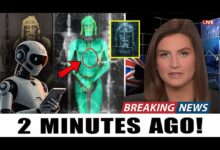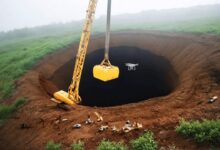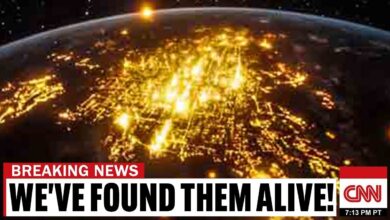Voyager Spacecraft Delivered what EVERYONE Ignored For Years – NASA Stunned
Voyager 1: The Silent Sentinel of Deep Space
In the vastness of space, where silence reigns and time stretches infinitely, a solitary traveler drifts far beyond the planets that birthed its fame. Voyager 1, launched by NASA in 1977, has become more than just a machine—it is humanity’s farthest-reaching ambassador, carrying not only instruments and data but the hope and curiosity of an entire species.
Once celebrated for its dazzling images of the gas giants, Voyager 1’s true legacy lies beyond Saturn’s rings and Jupiter’s storms. While the world marveled at swirling clouds and volcanic eruptions on distant moons, Voyager slipped past the orbits of the known, gliding through the invisible borders of our solar system into uncharted space. It did so silently—without spectacle—yet what it discovered would quietly redefine our understanding of the cosmos.
Its most profound contribution wasn’t a photograph. It was a revelation. Voyager 1 was the first to detect the heliosphere’s outer boundary—a vast, fluctuating bubble created by the sun’s solar wind, protecting our solar system from the harsh radiation and particles of interstellar space. This boundary, known as the heliopause, was once theoretical. Voyager made it real. It discovered that space wasn’t empty after all. Beyond the comforting pull of the sun, there were pressures, energies, and waves—cosmic weather, largely invisible but profoundly influential.
For years, these findings lingered in the background. The media focused on Saturn’s moons and Jupiter’s lightning, but buried within data logs and dense reports was a story of boundaries, fluctuations, and the breathtaking truth that our solar system floats not in stillness, but in a turbulent sea of galactic energy.
Even as Voyager aged, it refused to go quietly. By the early 2010s, its main thrusters—critical for keeping its antenna pointed at Earth—began to degrade. But NASA wasn’t ready to say goodbye. In a remarkable feat of engineering, the team sent a signal to activate Voyager’s backup thrusters—unused for 37 years. These components, designed in the 1970s, were never expected to function after decades of dormancy.
They worked flawlessly.
That ignition was more than a technical success; it was a resurrection. It meant Voyager could continue speaking to Earth, even from over 15 billion miles away. A spacecraft older than the internet had come back to life, not because it had to, but because its mission still mattered.
As Voyager’s nuclear power dwindled, NASA faced difficult choices. Instruments weren’t failing—they were being turned off, one by one, to conserve energy. Gone were the cameras, the glory tools. What remained were instruments that could detect magnetic fields, cosmic rays, and plasma waves—tools not for sight, but for sensing the heartbeat of the interstellar void. The spacecraft had transitioned from a planetary explorer into a deep-space sentinel.
And what it sensed was astonishing.
It recorded the pressure of interstellar plasma, the density of particles, the changes in magnetic field orientation. It noticed a boundary that wasn’t fixed, but pulsed—contracting and expanding like the breath of some unseen entity. Voyager wasn’t just floating through space. It was navigating a dynamic frontier.
And yet, these discoveries rarely made headlines. There was no photo to go viral, no ringed planet to celebrate. The data was subtle, mathematical, whispered in the language of scientists. But to those who listened closely, it was revolutionary. Voyager was showing us that space was not a void—it was alive, charged, and full of storms.
The public almost missed this. For years, only a small community of enthusiasts noticed what NASA’s cautious phrasing concealed. On platforms like Reddit, users pieced together clues from obscure updates and technical memos. “Voyager just left the bubble,” one thread declared. Others speculated that the spacecraft had entered an unknown pressure zone or that magnetic fluctuations hinted at something more than passive drift.
Why wasn’t NASA louder about this? Some accused them of secrecy. Others understood it as scientific prudence—interpreting the data took time, and certainty could not be rushed. The truth is, the heliopause was not a wall. It was a veil, a membrane, trembling with motion. Not so much crossed, as felt.
Still, Voyager pressed on, unbothered by headlines. It mapped this strange boundary with the patience only a machine could possess. Its instruments, prioritized and preserved with care, offered the world the first meteorological data of the interstellar environment—a cosmic weather report, 40 years in the making.
Even the moons it once passed began to take on new significance. Enceladus, once thought inert, was revealed to be geologically active—its geysers spraying water into space. Titan’s methane lakes became models for early Earth. Io’s volcanic fury demonstrated that even distant, frozen worlds could burn from within. These weren’t just moons. They were laboratories of alien geology, chemistry, and possibly biology. Voyager’s legacy seeded the missions that would follow—Cassini, New Horizons, and beyond.
But while those probes explore with cutting-edge tools, none will ever replicate Voyager’s achievement: to cross from the known into the unknowable.
Today, Voyager 1 continues its journey. Every pulse it sends is a miracle of endurance. Each bit of data must travel for over 22 hours to reach us. One day, that signal will stop. Not with a crash or fire, but a soft silence—its generators spent, its voice stilled. When that day comes, Voyager will still drift. For tens of thousands of years, it will wander the galaxy. Perhaps it will pass near another star. Perhaps it will never be found again.
But it will always have been.
It will always have marked the place where our solar system ends and interstellar space begins. Not just with numbers, but with meaning.
Voyager’s greatest gift wasn’t just its discoveries. It was the challenge it offered humanity: to listen when the noise stops. To hear the hum of the universe. To chart not only planets, but pressure. Not only orbits, but storms.
The golden record it carries may never be played. The photos it sent are long archived. But the maps—the true maps—are still unfolding. They show us not where we are, but what surrounds us. They whisper of cosmic tides and magnetic pulses. And they ask us, quietly but insistently:
Will we listen?
Because what Voyager found was not an end. It was a beginning.
Not the boundary of our reach—but the start of our understanding.




